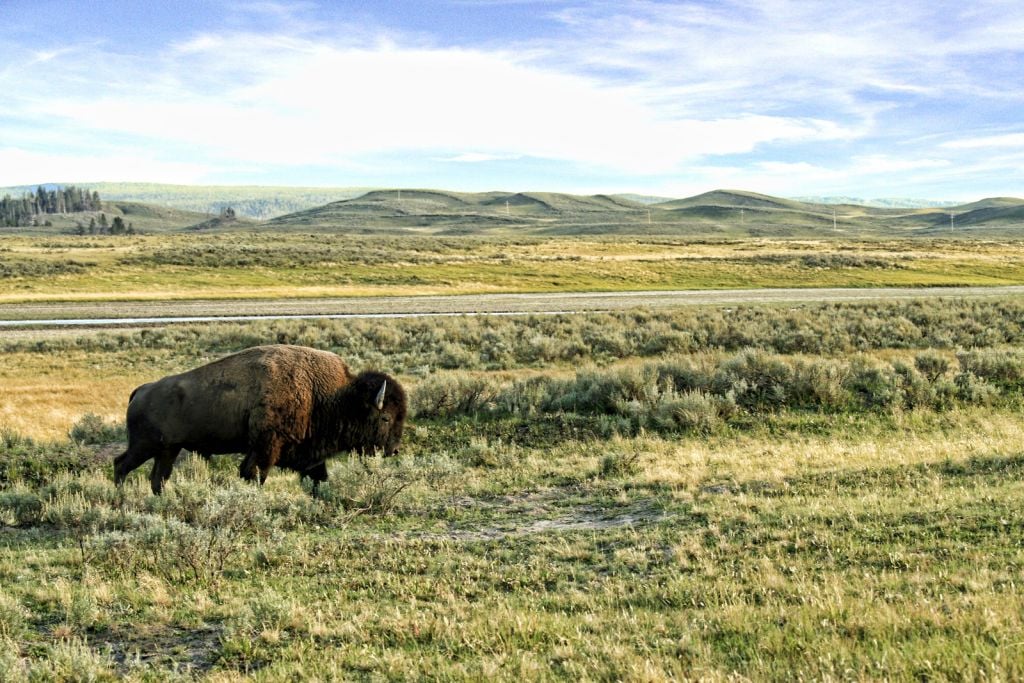10 Tips for Summer Wildlife Viewing in Yellowstone
Yellowstone Wildlife vIEWING
Yellowstone National Park is a place of natural wonders, geothermal phenomena, with an abundance of diverse, free-roaming wildlife. Wolves, bison, bears, otters, bald eagles, deer, elk, moose, ravens, foxes, and more call the park home. Each year these animals captivate park visitors from around the world. In the summertime, Yellowstone is full of new life, color and the weather is at its warmest. To have the best Yellowstone summer wildlife viewing experience it’s important to remember that the park’s animals are as wild as the landscape they inhabit.

Here are our top ten tips to help you make the most of your summertime wildlife viewing opportunities in Yellowstone:
1. Go where the wildlife is
Yellowstone’s huge, wide valleys make excellent habitats for wildlife and this is key to finding them. Hayden Valley is a prime spot, especially for bison in the late summer during their mating season, or “rut.” Mammoth Hot Springs seems to have elk almost year-round.
2. Early birds and night owls catch the worms
Yellowstone’s wildlife is most active in the early morning and evenings, away from the heat of the day. This is also the time when most park visitors have yet to arrive or have retired for the evening.
3. Take the time to prepare
It’s important to make sure you are prepared for your wildlife viewing adventure. Even in summer, you should pack warm clothing and dress in layers. Make sure you bring extra clothing in case the weather changes during your trip. Also, don’t forget to bring your binoculars and/or spotting scope!
4. Don’t feed wild animals
Do not feed any animals, even birds and squirrels. Consuming human food is unhealthy for wildlife. Once an animal associates humans with food, the animal can exhibit aggressive behavior in its attempts to find more. Store food in the car or hard-sided camper when not eating or attending to it. The common saying is, “a fed bear is a dead bear” and can apply to other animals as well.
5. Play it safe
It’s very important to maintain a safe distance from Yellowstone’s wildlife. Always make sure you keep at least 100 yards (91 m) between you and bears and wolves. Stay 25 yards (23 m) away from all other animals. If the animal moves closer to you—back away and give them space. Do not surround, crowd, or disrupt an animal’s path of movement. If your activity causes the animal(s) to change its ongoing behavior, whether the animal is eating, resting, standing still, etc., stop what you’re doing and move away. The goal of wildlife viewing is to observe animals without interrupting their normal activities and to avoid giving the animal the sense that you are a danger.
6. Be respectful and courteous
It’s always important to respect the wildlife and to not disturb them or their habitats. It’s also important to be respectful of other viewers and park property. Often you’ll know where wildlife has been spotted—you’ll notice park visitors in a turnout using binoculars and spotting scopes. When stopping to join, make sure you are courteous and safe in approaching the turnout and wildlife watchers. They may be willing to allow you to look through their scopes if you ask politely. Also, it’s critical to park your vehicle legally, and in a way that does not block traffic, damage vegetation or park resources.
7. Listen, don’t just look
Taking the time to listen to the natural sounds around you, this can help with spotting wildlife. You may hear the call of an animal, birds chirping and other noises that could tip you off to an animal being nearby.
8. Know your bear safety
When wildlife viewing it’s very important to always be prepared for your adventure. Carrying bear spray and knowing how to use it, could make all of the difference. Remember to stay 100 yards (91m) away from bears at all times and never run from a bear, they have an instinct to chase. Learn more about bear safety in Yellowstone.
9. The more photos you take, the better
Capturing the perfect photo of a wild animal can be challenging because they’re constantly moving. The more photos you snap, the more likely you will get the shot you wanted all along.
10. Take a tour with an expert guide
One of the safest and most productive ways to view wildlife in Yellowstone is to take a guided tour with a park expert. Discover the park’s wildlife on an Evening Wildlife Encounters tour or a Wake Up with Wildlife. There’s even a Picture Perfect Photo Safari with a professional photographer!
Start planning your visit to Yellowstone National Park with these Summer Packages and make your next story, a Yellowstone story!
For A World of Unforgettable Experiences® available from Xanterra Travel Collection® and our sister companies, visit xanterra.com.
Want to experience Yellowstone in-depth? See what makes Yellowstone National Park a great place to work for a season or longer!